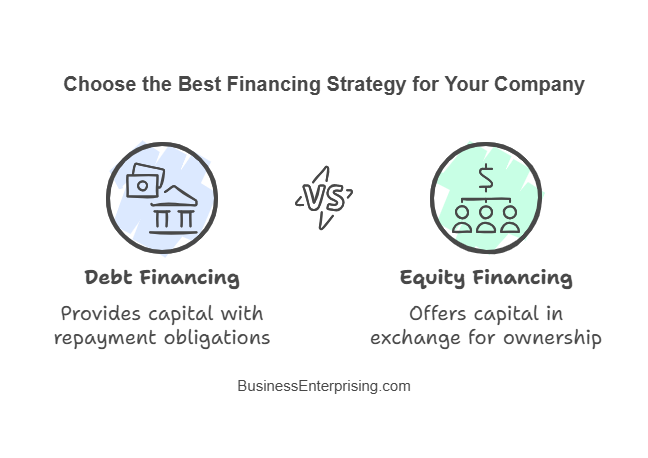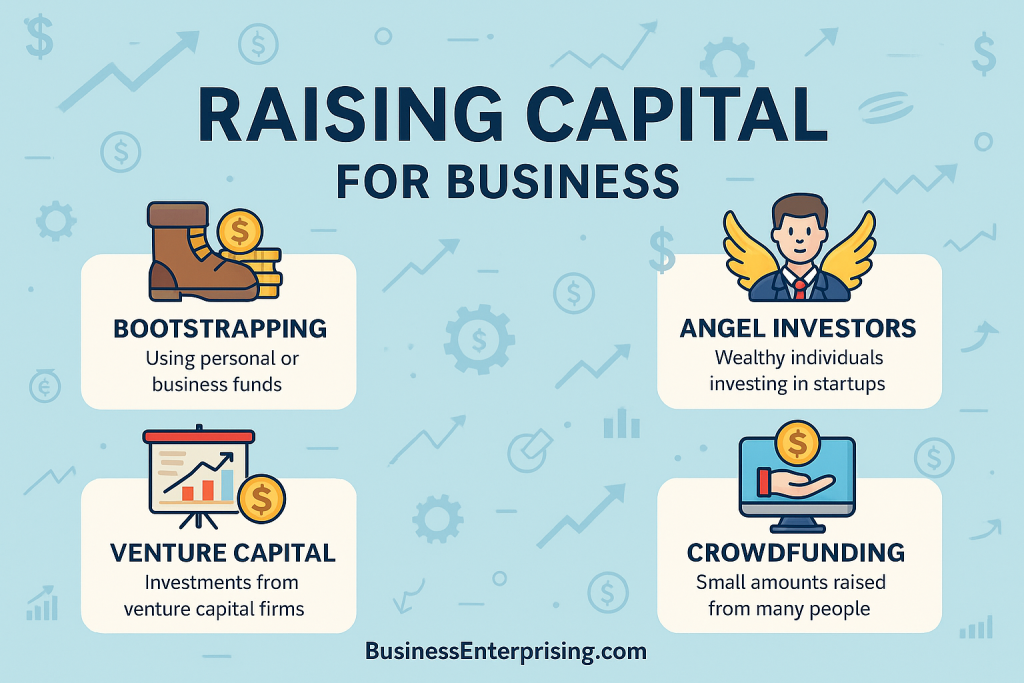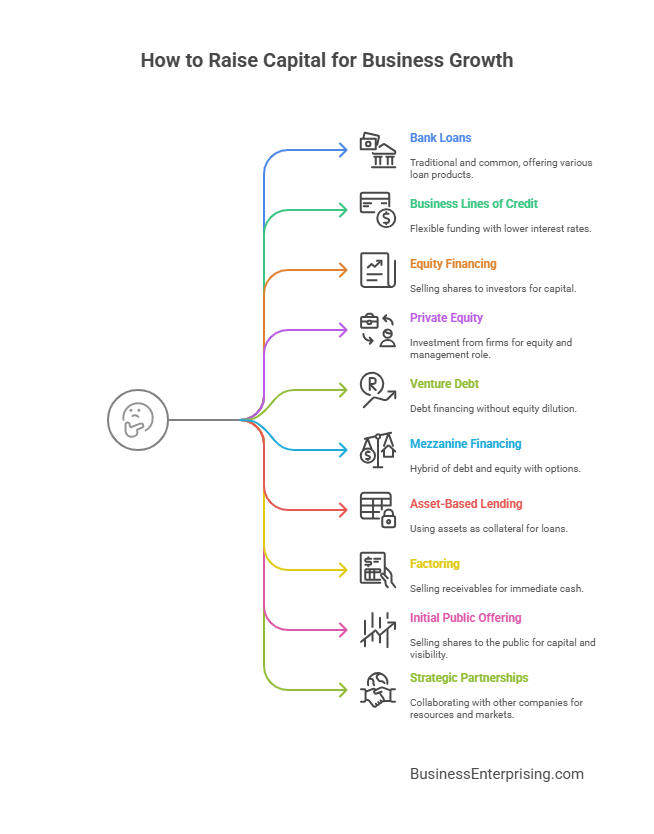 Raising capital for business is a critical component of growth and expansion, whether you’re launching a new startup or scaling an existing company. Therefore, understanding how to access and leverage various funding sources is essential. Additionally, navigating the capital-raising process with the right strategy can increase your chances of securing the financial resources your business needs. This comprehensive guide explores key strategies, funding options, and available opportunities, offering practical insights along the way. Startups and existing businesses alike can benefit from the detailed information provided.
Raising capital for business is a critical component of growth and expansion, whether you’re launching a new startup or scaling an existing company. Therefore, understanding how to access and leverage various funding sources is essential. Additionally, navigating the capital-raising process with the right strategy can increase your chances of securing the financial resources your business needs. This comprehensive guide explores key strategies, funding options, and available opportunities, offering practical insights along the way. Startups and existing businesses alike can benefit from the detailed information provided.
Capital serves as the lifeblood of any business, powering everything from product development to expansion. For startups, raising initial funds is vital to bring ideas to life, build teams, and reach early customers. Furthermore, securing the right funding early on sets the foundation for future growth. Existing companies, on the other hand, may seek additional capital to scale operations, enter new markets, or invest in innovation and infrastructure. Therefore, selecting the right funding path depends on business maturity and specific goals.
Locating Funds
The process of raising capital for business can often be complex and highly competitive. Therefore, entrepreneurs and business owners must gain a clear understanding of the various financing options available. Additionally, presenting a well-prepared and compelling case to investors or lenders is essential for securing the necessary funds. This guide explores multiple strategies for raising capital for business, ranging from traditional loans and equity financing to newer alternatives such as crowdfunding. Moreover, it helps identify which funding methods are most appropriate for startups compared to those better suited for established companies.
By exploring these diverse capital-raising strategies, you can take informed steps toward securing the funding your business requires. For deeper insights and personalized guidance, consider working with a business consultant. Additionally, explore trusted resources to begin your capital-raising journey with greater confidence. You may take a business funding online course to get started, read a book about business funding or speak to a business consultant to gain a better understanding. These are all options.
Strategies for Startups
-
Bootstrapping
Bootstrapping involves using personal savings or the revenue generated by the business to fund operations and support growth. Therefore, it is often an attractive option for entrepreneurs who want to maintain full control and ownership without relying on external funding sources. Additionally, bootstrapping eliminates the need to take on debt or give up equity, allowing business owners to make independent decisions without investor influence.
One of the primary advantages of bootstrapping is the ability to retain complete control over all aspects of the business. Moreover, since there is no external capital involved, there is no risk of equity dilution or long-term financial obligations. However, this approach also presents challenges. For example, limited access to capital can slow down growth and restrict opportunities for scaling. Furthermore, without a financial cushion, unexpected expenses or downturns may place additional strain on the business, making raising capital for business expansion even more difficult in the future.
To bootstrap effectively, entrepreneurs must focus on minimizing expenses by operating as lean as possible. Therefore, prioritizing only essential activities and delaying non-critical investments becomes important. Additionally, reinvesting early profits back into the business can help fund expansion and build momentum over time. Some entrepreneurs may also choose to utilize personal savings or seek modest contributions from family and friends to support initial needs. By staying disciplined and resourceful, businesses can use bootstrapping not only to survive but to build a solid foundation for long-term success.
-
Angel Investors
Angel investors are wealthy individuals who provide funding to startups in exchange for equity ownership or convertible debt. Therefore, they not only offer financial support but also contribute valuable expertise, industry insights, and professional networks. Additionally, many angel investors take an active role in the businesses they support, often serving as mentors and advisors to help founders navigate early-stage challenges.
One key advantage of working with angel investors is gaining access to experienced individuals who can offer strategic guidance and introduce valuable contacts. Furthermore, their involvement can boost your startup’s credibility and attract future investment opportunities. However, it’s important to weigh the trade-offs. Accepting capital from angel investors usually results in equity dilution, meaning you give up a portion of ownership. Additionally, their involvement may lead to a shared influence over business decisions, which could affect your autonomy as a founder.
For entrepreneurs focused on raising capital for business growth, attracting angel investors requires preparation and clarity. Developing a detailed business plan and a compelling pitch deck is essential. These materials should highlight the business model, market potential, and expected financial returns. Additionally, emphasizing the return on investment can help align your goals with those of potential investors. Networking plays a critical role as well. Therefore, attending startup events, engaging with investor groups, and using platforms like AngelList can expand your reach and improve your chances of making valuable connections. By clearly presenting your vision and demonstrating traction, you can build investor confidence and secure the funding needed to move your business forward.
-
Venture Capital
Venture capital (VC) firms offer funding to high-growth startups in exchange for equity ownership. Therefore, they are typically interested in businesses that demonstrate strong growth potential and scalable business models. Additionally, VC firms often seek out companies positioned to disrupt industries or expand rapidly in a short period. For many entrepreneurs, this type of funding plays a key role in raising capital for business expansion, product development, and market entry.
One major advantage of venture capital is the large infusion of funding it provides—often exceeding what angel investors or personal savings can offer. Furthermore, VC firms contribute more than just money; they bring strategic guidance, industry experience, and valuable connections that can accelerate business growth. However, there are trade-offs to consider. Venture capital usually involves significant equity dilution, meaning founders give up a substantial share of their company. Additionally, the pressure to meet aggressive growth targets and deliver strong returns can be intense.
To secure venture capital, startups must be well-prepared. This includes crafting a comprehensive business plan, outlining detailed financial projections, and developing a persuasive pitch. Furthermore, identifying VC firms that align with your industry and stage of growth improves your chances of success. Networking also plays a crucial role. Therefore, attending startup events, participating in incubators or accelerators, and leveraging warm introductions can help connect you with potential investors. Ultimately, presenting a compelling case that highlights your business’s market opportunity and growth strategy is essential for attracting VC funding and building long-term success.
-
Crowdfunding
Crowdfunding involves raising small amounts of capital from a large number of individuals, typically through online platforms. Therefore, it has become an increasingly popular method for entrepreneurs seeking alternative ways of raising capital for business ventures. Additionally, crowdfunding offers flexibility through various models, including reward-based, equity-based, and donation-based formats. Each option caters to different business needs, allowing founders to choose the most suitable approach based on their goals and growth stage.
One notable advantage of crowdfunding is its ability to reach a broad and diverse audience beyond traditional investors. Furthermore, a successful campaign can serve as early validation of the business idea, offering not just funding but also valuable market feedback. Another benefit is that many crowdfunding models do not involve repayment, enabling entrepreneurs to secure capital without taking on debt. However, the process does come with its own challenges. An effective campaign demands a well-executed marketing strategy to build visibility and engage supporters. Additionally, if funding targets are not met, the effort may result in lost time and missed opportunities.
To increase the likelihood of success, entrepreneurs should focus on developing compelling campaign materials that clearly communicate their value proposition. Moreover, early engagement with personal and professional networks can generate initial momentum and social proof. Consistently promoting the campaign throughout its duration is also key to maintaining interest. By selecting the right platform and preparing thoroughly, businesses can leverage crowdfunding not only to raise needed capital but also to strengthen brand presence and community support.
Popular Crowdfunding Platforms:
- Kickstarter (https://www.kickstarter.com/): Reward-based crowdfunding for creative projects and startups.
- Indiegogo (https://www.indiegogo.com/): Flexible crowdfunding platform for various types of projects.
- SeedInvest (https://www.seedinvest.com/): Equity-based crowdfunding for startups.
How to Launch a Successful Crowdfunding Campaign:
To launch a successful crowdfunding campaign, several key elements must be in place. First, it’s important to create a compelling campaign that clearly communicates the value proposition. Therefore, your messaging should emphasize the problem your product or service solves and why it matters to your target audience. Additionally, using high-quality visuals and engaging videos can help build trust and capture attention. These elements enhance professionalism and bring your concept to life in a way that resonates with potential backers.
Furthermore, effective promotion plays a vital role in gaining traction. This involves sharing your campaign across multiple channels, including social media, email marketing, and public relations efforts. By expanding your outreach, you can attract a broader audience and build sustained interest. Moreover, providing consistent updates and engaging with your audience throughout the campaign can help maintain momentum and strengthen supporter relationships.
Offering attractive rewards or incentives is another powerful strategy to increase backer participation. Whether it’s early product access, exclusive items, or personalized offers, well-designed rewards add appeal and motivate contributions. In addition, tailoring incentives to match backer interests can significantly boost results. Ultimately, when executed properly, a crowdfunding campaign becomes an effective tool for raising capital for business ventures. It also supports brand visibility, community building, and long-term customer engagement.
-
Incubators and Accelerators
Incubators and accelerators offer startups a valuable combination of funding, mentorship, and business development resources in exchange for equity. Therefore, they serve as powerful launchpads for early-stage companies looking to refine their ideas and scale quickly. These programs typically run for a fixed period, during which selected startups receive structured guidance and intensive support to help shape their business models, products, and go-to-market strategies.
One major advantage of joining an incubator or accelerator is the access to experienced mentors, valuable resources, and established networks. Additionally, these programs often culminate in demo days or investor presentations, creating opportunities for follow-on funding and increased visibility. Moreover, being part of a reputable program can boost credibility and open doors to future partnerships.
However, there are challenges to consider. The application process for incubators and accelerators is highly competitive, as many startups vie for limited spots. Furthermore, participation often requires giving up a percentage of equity, which can dilute ownership early in the company’s life cycle. Therefore, startups must weigh the trade-offs carefully.
By preparing a strong application and aligning with programs that match their industry and goals, startups can make the most of what incubators and accelerators offer. Additionally, the support gained through these programs can significantly enhance a startup’s ability to attract investment, build traction, and achieve sustainable growth.
Popular Incubators and Accelerators:
- Y Combinator (https://www.ycombinator.com/): One of the most well-known startup accelerators.
- Techstars (https://www.techstars.com/): Provides funding, mentorship, and access to a global network of investors and partners.
- 500 Startups (https://500.co/): Early-stage venture fund and seed accelerator.
How to Apply for Incubators and Accelerators:
To apply for incubators and accelerators effectively, several important steps should be followed. First, it is essential to research programs that align with your specific industry, goals, and stage of business development. Additionally, targeting the right programs increases your chances of acceptance and ensures the support you receive is relevant and valuable.
Once you have identified suitable programs, the next step is to prepare a strong and persuasive application. Therefore, it’s important to clearly highlight your team’s strengths, the business’s growth potential, and the size of the market opportunity. Moreover, demonstrating a clear understanding of your competitive advantage can set your application apart from others.
In addition to a solid application, many programs require a live pitch or interview. As a result, you should be prepared to present your business confidently and explain your progress to date. Furthermore, showcasing any traction or early successes—such as customer interest, revenue, or partnerships—can strengthen your case and build credibility. By approaching the process strategically and preparing thoroughly, you can improve your chances of being accepted into a program that will help accelerate your startup’s success.
- Research programs that align with your industry and business stage.
- Prepare a strong application that highlights your team’s capabilities, business potential, and market opportunity.
- Be prepared to pitch your business and demonstrate traction or early successes.
-
Government Grants and Programs
Many governments offer grants, loans, and support programs to encourage entrepreneurship and innovation. These programs provide non-dilutive funding, meaning you do not have to give up equity in your company.
- Advantages: Non-dilutive funding, potential for additional resources and support.
- Challenges: Competitive application process, stringent eligibility requirements.
How to Find Government Grants and Programs:
- Research local, state, and federal government websites for available grants and programs.
- Use online resources like Grants.gov (https://www.grants.gov/) to search for funding opportunities.
- Consult with local business development centers or economic development agencies for guidance.
-
Business Competitions
Business competitions provide startups with the opportunity to pitch their business ideas to a panel of judges in exchange for funding, mentorship, and other resources.
- Advantages: Access to funding, mentorship, and exposure.
- Challenges: Highly competitive, time-consuming application process.
Popular Business Competitions:
- MIT $100K Entrepreneurship Competition (https://entrepreneurship.mit.edu/competitions/100k/)
- Startup World Cup (https://www.startupworldcup.io/)
- Hult Prize
How to Succeed in Business Competitions:
- Develop a compelling pitch that clearly articulates your business idea, market opportunity, and growth potential.
- Practice your pitch and be prepared to answer questions from judges.
- Network with other participants and judges to build valuable connections.
Strategies for Existing Companies
-
Bank Loans
Traditional bank loans are a common way for existing businesses to raise capital. Banks offer various loan products, including term loans, lines of credit, and equipment financing.
- Advantages: Access to significant capital, no equity dilution.
- Challenges: Requires strong credit history and collateral, interest payments.
How to Secure a Bank Loan:
- Prepare detailed financial statements and business plans.
- Demonstrate a strong credit history and repayment ability.
- Approach banks with a clear purpose for the loan and how it will be used to grow the business.
-
Business Lines of Credit
A business line of credit provides flexible funding that allows companies to draw funds as needed up to a predetermined limit. It functions similarly to a credit card but often with lower interest rates.
- Advantages: Flexible access to funds, interest paid only on drawn amounts.
- Challenges: Requires strong credit history, potential fees for unused funds.
How to Obtain a Business Line of Credit:
- Maintain a good credit score and financial health.
- Prepare detailed financial documents and business plans.
- Approach banks or financial institutions that offer business lines of credit.
-
Equity Financing
Equity financing involves raising capital by selling shares of the company to investors. This can be done through private placements, public offerings, or selling shares to existing shareholders.
- Advantages: Access to significant capital, no repayment obligation.
- Challenges: Equity dilution, potential loss of control.
How to Raise Equity Financing:
- Prepare a detailed business plan and financial projections.
- Identify potential investors, such as venture capital firms, private equity firms, or institutional investors.
- Conduct thorough due diligence and negotiate terms with investors.
-
Private Equity
Private equity firms invest in established companies with the potential for significant growth. They provide capital in exchange for equity and often take an active role in the management and strategic direction of the company.
- Advantages: Access to large amounts of capital, strategic guidance and support.
- Challenges: Significant equity dilution, potential loss of control.
How to Attract Private Equity Investment:
- Demonstrate a track record of success and growth potential.
- Prepare detailed financial statements and business plans.
- Network with private equity firms and industry contacts.
-
Venture Debt
Venture debt is a type of debt financing specifically designed for venture-backed companies. It provides capital to support growth without diluting equity.
- Advantages: Access to capital without significant equity dilution, flexible terms.
- Challenges: Interest payments, potential warrants or options.
How to Secure Venture Debt:
- Have existing venture capital backing.
- Demonstrate strong financial health and growth potential.
- Approach venture debt providers with a clear plan for using the funds to drive growth.
-
Mezzanine Financing
Mezzanine financing is a hybrid of debt and equity financing. It provides capital in the form of subordinated debt or preferred equity, often with warrants or options attached.
- Advantages: Access to capital with flexible terms, potential for lower equity dilution.
- Challenges: Higher cost of capital, complex terms and conditions.
How to Use Mezzanine Financing:
- Prepare detailed financial statements and business plans.
- Demonstrate strong cash flow and repayment ability.
- Approach mezzanine financing providers and negotiate terms.
-
Asset-Based Lending
Asset-based lending involves securing a loan using the company’s assets, such as inventory, accounts receivable, or equipment, as collateral.
- Advantages: Access to capital based on asset value, flexible use of funds.
- Challenges: Requires valuable collateral, potential for higher interest rates.
How to Secure Asset-Based Lending:
- Prepare detailed financial statements and asset valuations.
- Maintain strong credit history and financial health.
- Approach asset-based lenders and negotiate terms.
-
Factoring
Factoring involves selling accounts receivable to a third party (the factor) at a discount in exchange for immediate cash. This provides businesses with quick access to capital based on outstanding invoices.
- Advantages: Immediate access to cash, no debt incurred.
- Challenges: Potentially high fees, loss of a portion of accounts receivable value.
How to Use Factoring:
- Identify a reputable factoring company.
- Provide detailed accounts receivable documentation.
- Negotiate terms and fees with the factor.
-
Initial Public Offering (IPO)
An IPO involves selling shares of the company to the public for the first time. This process provides significant capital and increases the company’s visibility and credibility.
- Advantages: Access to large amounts of capital, increased visibility and credibility.
- Challenges: Expensive and complex process, significant regulatory requirements.
How to Go Public:
- Prepare detailed financial statements and business plans.
- Hire investment banks and legal advisors to manage the IPO process.
- Comply with regulatory requirements and conduct a roadshow to attract investors.
-
Strategic Partnerships and Joint Ventures
Strategic partnerships and joint ventures involve collaborating with other companies to achieve mutual business goals. These arrangements can provide access to capital, resources, and new markets.
- Advantages: Access to capital, resources, and new markets, shared risk.
- Challenges: Potential for conflicts of interest, complex negotiations.
How to Form Strategic Partnerships:
- Identify potential partners with complementary strengths and resources.
- Negotiate terms and structure the partnership agreement.
- Develop a collaborative business plan and execute joint initiatives.
Conclusion
Raising capital for business is a critical component of both growth and long-term sustainability. Whether you are launching a startup or expanding an established company, securing the right funding is essential. Therefore, understanding the available strategies and how they align with your goals is key. Additionally, the variety of capital-raising options allows businesses to choose approaches that suit different needs and stages.
For startups, several funding avenues are worth exploring. For example, bootstrapping, angel investors, venture capital, crowdfunding, incubators, government grants, and business competitions can provide early-stage support. Moreover, each method offers unique benefits and potential trade-offs. Therefore, selecting the right strategy depends on the startup’s industry, risk tolerance, and long-term objectives. Additionally, seeking guidance early in the process can help avoid missteps.
Existing businesses, on the other hand, typically have access to a wider range of funding solutions. These include bank loans, lines of credit, equity financing, private equity, venture debt, mezzanine financing, asset-based lending, factoring, IPOs, and strategic partnerships. Furthermore, each option varies in complexity, cost, and structure. As a result, companies must evaluate these options carefully to align them with their growth strategy and current financial position.
By understanding and leveraging these capital-raising strategies, businesses can strengthen their ability to secure essential financial resources. Additionally, tailoring the funding approach to the company’s specific stage and goals increases the likelihood of success. Therefore, whether you are seeking startup funding or growth capital, the right strategy can make a measurable difference.
To explore specific funding opportunities in more detail, consider speaking with a business consultant. Furthermore, online resources and trusted advisors can provide insights and help you take immediate action toward raising capital. You may also take on online business funding course, or read a business funding book to get started.



